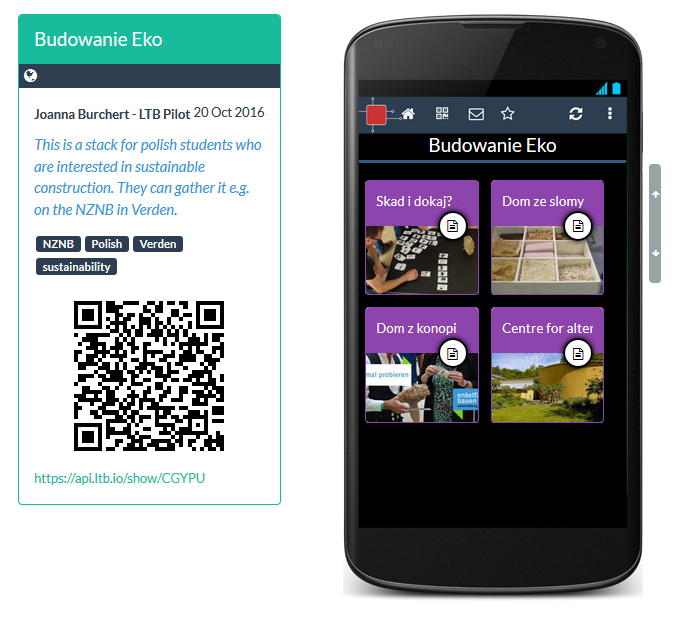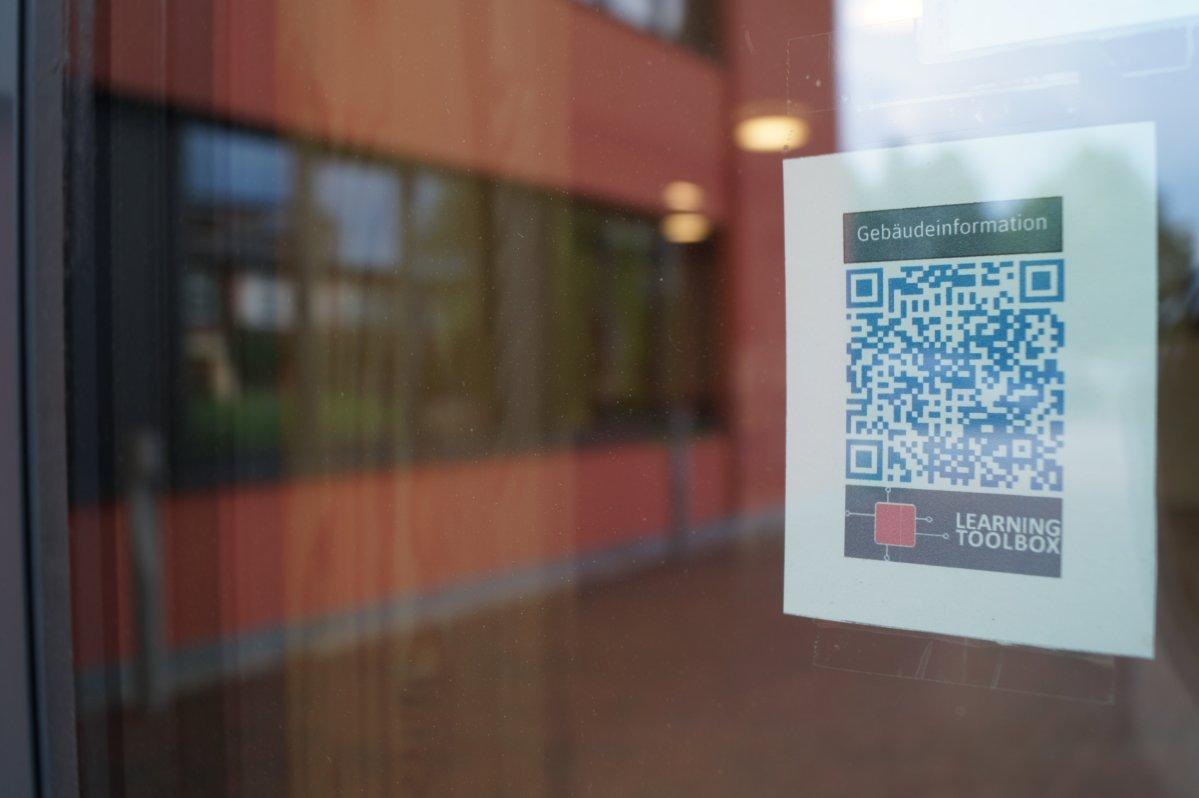Bridging Work and Learning in a Network for Ecological Construction
Main impacts
- Allowed better targeting of digital materials to interests and capabilities of learners
- Improved awareness of the potential to reuse documentation for learning on the site
- LTB allowed the network to adopt a new service of providing digital learning materials
The situation before Layers
Highlights
The The Network for Ecological Construction Work (NNB, represented in Layers by AGENTUR) and the The North German Centre for Sustainable Construction (NZNB) have the aim to spread energy-efficient and sustainable building. Sustainable building is one of the most promising ways to reduce CO2 emission and important for healthy living and working. As one way to inform and to inspire craftsmen, house builders and students about sustainable construction, NNB and NZNB have created a permanent exhibition. In addition, they want to use the potential of digital media to address new target groups. This was their main motivation to cooperate in the Learning Layers project.
Description
The NNB in Verden is a network of companies with the aim to spread energy-efficient and sustainable building. It addresses craftsmen and public as well as private house builders. The NNB is active in research and development, consultation, further education of craftsmen and multipliers, advertisement and - of course - it builds houses. In its core, the NNB consists of 14 companies from different sectors (architecture, carpentry, building technology, trade) which partly work ecologically and partly traditionally. This combination of different trade disciplines is useful to reflect how processes on building sites can be improved and to acquire new building projects.
The NZNB is a training institution specialized in explaining sustainable construction to students and teachers. It also manages an innovative bureau house which was built by the NNB out of straw and wood and which is a remarkable model project in the area of sustainable construction. This house harbors NNB’s and NZNB’s highly recognized and extensive permanent exhibition on sustainable building: nachhaltig.bauen.erleben (http://www.nachhaltig-bauen-erleben.de/).
Before the Learning Layers project, NNB and NZNB were not using the opportunities which digital media provide to enhance learning in informal as well as non-formal settings. The permanent exhibition only included information which was accessible locally: it was difficult for visitors to collect their new insights or information sources. When non-formal education took place, it passed the chance to integrate modern web 2.0 tools: participation took place locally but was not supported beyond. The NNB and NZNB were efficacious especially in local contexts and in groups who were already sensitive for sustainability and ecological construction.One could say: everything worked, but the opportunities of digitization - connection to a wider audience, opening of wider participation opportunities, collection of information during the exhibition visits - were not used.
What Layers did
Highlights
Media training is an obvious answer to the necessity of capacity building. In the context of networks, however, it was not enough to offer courses - regular input during the bi-weekly meetings of the NNB and continual accompanying was important to assure that digital media became an intrinsic part of the networks’ strategies and knowledge sharing. Within the Layers project, capacity building took place, a digital concept for the permanent exhibition was realized and tools to support work based learning were developed. A spin-off project (nabus) was successfully applied.
Description
The NNB and NZNB regarded the Layers project as a good opportunity to learn how to use digital tools to support informal learning in working life and in their exhibition. The first steps here included the collection of ideas and digital media training, e.g. on social networks, Augmented Reality, user generated content (video making and annotation), or shaping of a modern website. Regular input during the bi-weekly meetings of the NNB/ AGENTUR assured that digital media became relevant as an issue and raised interest for the Layers tools, especially the Learning Toolbox (LTB) and Ach So!. Based on such impulses, a digital concept for the exhibition was developed and realized (see below): the NNB and NZNB made high investments in infrastructure to assure that learning with mobile tools becomes possible. Besides discussions in the bi-weekly network meetings, talks with single companies took place and implementation strategies for the interested SMEs were reflected. The NNB developed concepts how to use the LTB for work based learning, advertisement and further education. Together with the NZNB, a spin-off project was applied for and realized in which the LTB and other digital tools (e.g. a modern website) are part of learning for sustainable construction.
The situation after Layers
Highlights
The digital concept for the permanent exhibition is is action - external tools (QR codes and a collecting tool) as well as the Learning Toolbox (LTB) are in use. Strategies how to support learning at work and further education with digital media were developed and part of actual actions, e.g. an improved website is actually under construction, there are LTB stacks for house information, for the exhibition and for organization and learning on building sites. NNB and NZNB turn into multipliers of digitally enhanced learning.
Description
The permanent exhibition informs about sustainable construction. Since the Layers project, visitors (house builders, architects, craftsmen, students) get additional information about objects and collect such information in a digital portfolio. With the LTB, the learning opportunities were elaborated by combining information about exhibition objects with learning games, other relevant web sources etc. One example for this is the stack “Budowanie eco”.

Stacks for building process improvement were designed by NNB to show that using smart digital devices - and at the same time giving more responsibility to the craftsmen level - allows more efficiency of work processes. E.g. in case of problems, craftsmen can call each other directly because they have their contact data instead of relying on bosses and architects as intermediaries. Documentation of work turns into a form of learning when it is combined with reflection.
The NNB developed a LTB stack to present its innovative strawbale building and tries to disseminate this strategy of “explaining the sustainability of a house” by involving the initiative “Grüne Hausnummer”. In this case, the LTB would not only support individual, but also organisational learning and the learning of a society by showing that sustainable building is possible and already here.
Furthermore, the LTB is used for further education of trainers and teachers in the nabus project. NZNB and NNB see the LTB as a good tool for flexible forms of further education (learning in micro units, “contextual learning” as connection of the physical setting with the digital world).
By addressing a multitude of network partners, the NNB and NZNB turn into multipliers of digitally enhanced learning (see Learning Toolbox as Support for Organisational Learning and Cooperation at a Construction Site in Verden - Instances of change). The various use have created opportunities for new ways to use the LTB, also it has shown the possibility to provide services from the NNB that could impact its potential of growth.

Impact that Layers created
Changed learning practices
Changed learning practices are tangible at different levels. At the level of the permanent exhibition, the NNB and NZNB have realized that too much information is as problematic as a lack of information. Therefore, in the exhibition, they build up the presented digital texts in a manner which allows to firstly gather an overview and then to go into depth. The possibility to view information on one’s own device is appreciated by the visitors of the exhibition. The possibility to collect information helps to change the learning horizon - from learning during the exhibition to a more longitudinal learning experience.
At the level of individual and organisational learning in the network companies, the change of learning practices can be described as an enhanced openness towards digital media as tools to support learning, advertisement, transparency and job attractivity. But also, the use of the LTB is connected to changing roles of craftsmen and executives.
At the level of society, changed learning practices come into reach when more house information is available so that reflection processes about questions like “what does a house consist of?”, “how do building materials influence us?”, “is building with ecological materials possible?” were enhanced.
Extended trust building and personal networks
During the Learning Layers project, the NNB network developed a concept how to share information. In this concept, trust is a main pillar: “Information per se is worthless. You need to know where it comes from”. Therefore, e.g. the exhibition texts and objects are presented in a manner which clearly shows their origin or author - “select, assess, link” can be seen as the core principles. Tours through the exhibition are always guided by reliable experts.The exhibition therefore is at the same time a way to build up trust in the network as a network of experts.
Improved the creation and use of learning resources
Digital media became an issue in the network during the Learning Layers project - an intense exchange about their chances and problems took place. The NNB considers to develop learning resources as service concept, which is a new task for it. With the idea to just-in-time information about the building site, a change of the craftsmen roles occurs towards more responsibility and self reflection.
Enhanced digital competence
The NNB/AGENTUR as well as the NZNB have realized the potential of digital media and now know approaches like user generated content, video annotation, Augmented Reality, modern website shaping. They realized how easy it is to connect professionally organization and learning. Also, they have reflected how to implement digital tools like the LTB into everyday’s work, further education and the permanent exhibition.
Bridging learning contexts
The NNB/AGENTUR as well as NZNB reflected that work documentation is not only a form of work organization, but that it also provides great opportunities for learning which can become visible in work process improvements. So, the sensitivity for learning in work grew during the Layers project. This sensitivity will perspectively also become visible in the cooperation across trades: the single trades will better understand what others do when it is mirrored in the LTB work documentations. In the permanent exhibition, the local learning context is transcended into further use by the personal portfolio and the LTB stacks.
Improved take-up of Innovation
Due to the rise of media literacy in the network, it is easier for it to pick up innovations in the field of digital media. Digital media is used to support learning in the exhibition and on the building site, which is an instance of organisational learning. Especially the LTB will be a driver for further innovations and projects of the NNZ and NZNB.
Further Reading
Contributing Authors
Thomas Isselhard, Enno Precht (AGENTUR), Joanna Burchert
